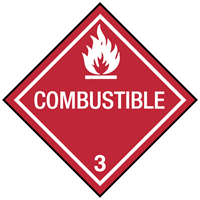
 Print
Print
Chemical Datasheet
DIMETHYL SUCCINATE |

|
Chemical Identifiers
| CAS Number |
UN/NA Number |
DOT Hazard Label |
USCG CHRIS Code |
- 106-65-0

|
|
|
|
| NIOSH Pocket Guide |
International Chem Safety Card |
|
none
|
none
|
NFPA 704
data unavailable
General Description
Colorless liquid. (USCG, 1999)
Hazards
Reactivity Alerts
none
Air & Water Reactions
Water soluble.
Fire Hazard
This chemical is combustible. Vapor forms explosive mixtures with air. (NTP, 1992)
Health Hazard
May be harmful by inhalation, ingestion or skin absorption. May cause irritation. (USCG, 1999)
Reactivity Profile
DIMETHYL SUCCINATE reacts with acids to liberate heat along with methanol and succinic acid. May react with strong oxidizing acids to liberate enough heat to ignite the reaction products. Heat is also generated by the interaction with caustic solutions. Flammable hydrogen is generated with alkali metals and hydrides.
Belongs to the Following Reactive Group(s)
- Esters, Sulfate Esters, Phosphate Esters, Thiophosphate Esters, and Borate Esters
Potentially Incompatible Absorbents
No information available.
Response Recommendations
Isolation and Evacuation
Excerpt from ERG Guide 128 [Flammable Liquids (Water-Immiscible)]:
IMMEDIATE PRECAUTIONARY MEASURE: Isolate spill or leak area for at least 50 meters (150 feet) in all directions.
LARGE SPILL: Consider initial downwind evacuation for at least 300 meters (1000 feet).
FIRE: If tank, rail tank car or highway tank is involved in a fire, ISOLATE for 800 meters (1/2 mile) in all directions; also, consider initial evacuation for 800 meters (1/2 mile) in all directions. (ERG, 2024)
Firefighting
Fire Extinguishing Agents: Carbon dioxide, dry chemical, alcohol foam. (USCG, 1999)
Non-Fire Response
SMALL SPILLS AND LEAKAGE: If you spill this chemical, use absorbent paper to pick up all liquid spill material. Seal the absorbent paper, as well as any of your clothing which may be contaminated, in a vapor-tight plastic bag for eventual disposal. Wash any surfaces you may have contaminated with a soap and water solution. Do not reenter the contaminated area until the Safety Officer (or other responsible person) has verified that the area has been properly cleaned.
STORAGE PRECAUTIONS: You should store this chemical under ambient temperatures, and keep it away from oxidizing materials. (NTP, 1992)
Protective Clothing
Wear self-contained breathing apparatus, rubber boots and heavy rubber gloves. (USCG, 1999)
DuPont Tychem® Suit Fabrics
No information available.
First Aid
EYES: First check the victim for contact lenses and remove if present. Flush victim's eyes with water or normal saline solution for 20 to 30 minutes while simultaneously calling a hospital or poison control center. Do not put any ointments, oils, or medication in the victim's eyes without specific instructions from a physician. IMMEDIATELY transport the victim after flushing eyes to a hospital even if no symptoms (such as redness or irritation) develop.
SKIN: IMMEDIATELY flood affected skin with water while removing and isolating all contaminated clothing. Gently wash all affected skin areas thoroughly with soap and water. If symptoms such as redness or irritation develop, IMMEDIATELY call a physician and be prepared to transport the victim to a hospital for treatment.
INHALATION: IMMEDIATELY leave the contaminated area; take deep breaths of fresh air. If symptoms (such as wheezing, coughing, shortness of breath, or burning in the mouth, throat, or chest) develop, call a physician and be prepared to transport the victim to a hospital. Provide proper respiratory protection to rescuers entering an unknown atmosphere. Whenever possible, Self-Contained Breathing Apparatus (SCBA) should be used; if not available, use a level of protection greater than or equal to that advised under Protective Clothing.
INGESTION: DO NOT INDUCE VOMITING. If the victim is conscious and not convulsing, give 1 or 2 glasses of water to dilute the chemical and IMMEDIATELY call a hospital or poison control center. Be prepared to transport the victim to a hospital if advised by a physician. If the victim is convulsing or unconscious, do not give anything by mouth, ensure that the victim's airway is open and lay the victim on his/her side with the head lower than the body. DO NOT INDUCE VOMITING. IMMEDIATELY transport the victim to a hospital. (NTP, 1992)
Physical Properties
Flash Point:
185°F
(NTP, 1992)
Lower Explosive Limit (LEL):
1 %
(NTP, 1992)
Upper Explosive Limit (UEL):
8.5 %
(NTP, 1992)
Autoignition Temperature:
689°F
(USCG, 1999)
Melting Point:
67.1°F
(NTP, 1992)
Vapor Pressure:
0.3 mmHg
at 68°F
(NTP, 1992)
Vapor Density (Relative to Air): data unavailable
Specific Gravity:
1.117
(USCG, 1999)
- Denser than water; will sink
Boiling Point:
385.5°F
at 760 mmHg
(NTP, 1992)
Molecular Weight:
146.14
(NTP, 1992)
Water Solubility:
greater than or equal to 100 mg/mL
at 73°F
(NTP, 1992)
Ionization Energy/Potential: data unavailable
IDLH: data unavailable
AEGLs (Acute Exposure Guideline Levels)
No AEGL information available.
ERPGs (Emergency Response Planning Guidelines)
No ERPG information available.
PACs (Protective Action Criteria)
| Chemical |
PAC-1 |
PAC-2 |
PAC-3 |
| Butanedioic acid, dimethyl ester; (Succinic acid, dimethyl ester) (106-65-0)
|
2.5 ppm |
28 ppm |
170 ppm |
(DOE, 2024)
Regulatory Information
EPA Consolidated List of Lists
No regulatory information available.
CISA Chemical Facility Anti-Terrorism Standards (CFATS)
No regulatory information available.
OSHA Process Safety Management (PSM) Standard List
No regulatory information available.
Alternate Chemical Names
- BUTANEDIOIC ACID, DIMETHYL ESTER
- DBE 4
- DIMETHYL BUTANEDIOATE
- DIMETHYL SUCCINATE
- METHYL SUCCINATE
- SUCCINIC ACID, DIMETHYL ESTER


 Print
Print
